This Gun for Hire (1943)
Directed by: Frank Tuttle
Written by: Albert Maltz, Graham Greene, W.R. Burnett
Starring: Alan Ladd, Laird Cregar, Robert Preston, Veronica Lake
USA
AVAILABLE ON BLU-RAY: NOW, from EUREKA ENTERTAINMENT
RUNNING TIME: 83 mins
REVIEWED BY: Dr Lenera
Hit man Philip Raven kills a blackmailer and is paid off by his employer Willard Gates in “hot” money who then tells the police that a clerk of his had money robbed. Meanwhile, nightclub singer Ellen Graham, girlfriend of police Lieut. Crane who’s after Raven, is enlisted by a Senate committee to help investigate a company named Nitro, which could be selling army secrets to the Japanese, and for whom Gates works. The paths of Ellen and the vengeful Raven are soon about to cross, but isn’t Raven a cold-blooded killer?….
Albert Maltz, the co-writer of the screenplay for this film, once said, “it was a very creaky melodrama – in my opinion, pretty second rate. It doesn’t stand up at all and I just don’t know why it was so successful in the way it was”. Well, it seems that he’s very in the minority as This Gun For Hire became regarded as an important work in the film noir genre and I was very much looking forward to seeing it. It’s a early example; Double Indemnity may have defined the genre in 1946 but it was very much alive and well in the years leading up to 1946, the year of the release of Billy Wilder’s seminal classic, and this was one of the first to get a lot of attention, much of it of course due to Alan Ladd who made a sensational movie debut as a callous, un-smiling yet rather contradictory killer. Within just a few minutes of seeing him on screen, I could see that he was the model for a great many similar characters played by others that came after, especially Alain Delon’s Jef Costello in Jean-Pierre Melville’s great Le Samourai, right down to the way he dressed; even certain scenes in that movie very much echo ones in this one. But it’s also a cracking, fast paced and well plotted yarn, showcasing the writer of its source novel Graham Greene’s strong and somewhat ironic plotting at its best, and without a single scene or even a shot going to waste; it’s a really tightly wound piece, yet one which still gives scenes time to breath when it is necessary, and makes the very most of its settings, especially a gloomy factory and railway depot which really bring out the best in cinematographer John Seitz, clearly practising for his incredible work on three certain Wilder masterpieces.
The 1936 Greene novel was called A Gun For Sale in the UK, though it went under its original title in the U.S. It took place in the same universe as his Brighton Rock which was of course made into a superb film in 1947. Several movie studios considered obtaining rights to it before Paramount did so the same year, immediately announcing Gertrude Michael as a possible star. A few months later, the cast was announced as being Akim Tamiroff, Ray Milland, and Ida Lupino, with Dore Schary writing the script, but production costs stopped things from happening several times until 1941, with Frank Tuttle assigned as director. Albert Maltz and W. T. Burnett wrote a screenplay which moved from the original British setting to an American one, changed most of the character names and made other alterations. Paramount didn’t want Alan Ladd’s handsome mug ruined, so his character Raven was disfigured in the wrist instead of on his face. Veronica Lake was announced early as a female lead, with Macdonald Carey mooted as Michael Crane, the part eventually played by Robert Preston. Ladd was being discussed as the breakout star even during shooting, despite being fourth billed, though he collapsed on the set due to pneumonia and was off the film for a week. Dickie Jones [‘Raven as a Boy’] and Hermine Sterler [‘Raven’s Aunt’] are listed in studio records as members of the cast, but these and maybe other scenes were cut before the film’s release, losing 12 minutes. The commercially and critically successful film led to three more movies pairing Ladd and Lake, and was remade in 1958 and 1990.
The beginning is fantastic and lets you know that Ladd is really the male star of this movie, and not just in terms of having considerably more time than Robert Preston and Laird Cregar. Raven is woken up by his alarm clock and gets dressed, puts a gun and an envelope in a bag, then lets his cat in and gives him or her some milk. In comes his landlady who shoes the moggy away; Raven responds by roughly grabbing her, tearing her dress in the process, then slapping her in the face. In the space of a minute we get both Raven’s nice side and his bad side, the latter side getting even stronger when he calmly carries out a hit and also shoots the target’s fleeing girlfriend through a door with cold precision, before picking up papers with some kind of formula on them and putting then in his bag . Surely this character is evil, the kind who’s beyond any redemption and not we should have any sympathy for even if we watch him go about his business with fascination? Yet he gives a ball back to a disabled child sitting on the stairs in the victim’s hotel, and we’ve seen him show affection for the cat, so he does have compassion. When going to Willard Gates, the guy who ordered this hit, Gates asks him, “how does it feel when you’re doing this”? Raven’s response is, “I feel fine” – yet we can’t help but sympathise a little with his loneliness. Throughout the film, our feelings regarding this character are constantly played with in a clever and really rather modern manner. Soon after this he goes to buy a coat for some woman. We never find out who this woman is, but isn’t it just so ironic that it’s an act of kindness that puts the police on his trail, the money he uses to pay for it being marked?
So he goes on the run but also wants to pay Gates back for his treachery, especially seeing as Gates reported the bills to the cops as stolen from his company, Nitro Chemical Corporation of Los Angeles. Then we’re introduced to the other thread of the plot and Veronica Lake, one of the few female stars of the time who was even shorter than Ladd whose low stature is virtually impossible to tell in this film, slinking around in one of Gates’s nightclubs ‘singing’ a song while also doing magic tricks. Lake pulls this and a later number off so well that you probably wouldn’t know that her singing voice is dubbed. Lake’s character is on a mission to investigate Gates and whoever his boss is, the two possibly trying to undermine the war effort. She tells her cop boyfriend Michael Crane that she has to go to Los Angeles for this ‘job’ that she can’t reveal to him and is actually a bit sordid, while he’s on a job himself – trying to catch Raven – which requires him to not to back to Los Angeles. Some modern viewers won’t like his line to her, “look sugar, what does it take to darn my socks, cook my corn beef and cabbage, and sort of confine your magic to one place and one customer”, but it was 1943. Crane is soon on Raven’s trail, then Raven gets on a train that Gates happens to be on. And Ellen is also on it, and decides to sit next to Raven. Gates sees them seated together, and assumes that she’s aiding Raven though decides that she’s for the chop, though it’s really for the wrong reason. In fact Gates never does learn of Ellen’s real role, and her being a spy gets forgotten about by the narrative. Likewise, the colourless Crane has so little importance on events, though this seems to be a wry mocking of what were already becoming conventions.
Director Frank Tuttle, not a well known name at all, handles well sequences in a baroque house while thunder and lightning rage in one of several slight parodic touches, and particularly in a factory/rail yard depot where Seitz’s creative shadow-filled cinematography really gets under way. The speed at which all this is taken is quite something – this is definitely one of those old movies that you should show to heathens who say that old movies are boring – yet we’re still given time for the scenes between our heroine and our anti-hero to breathe. I don’t think that either party falls for the other one; it’s more that he’s struck by her compassion even though he’s kidnapped her, and she sees some goodness in him that could possibly be brought out, along with the fact that he could be very useful for her. Raven’s explanation of why he kills may seem dated and too pat, but actually a childhood like his can sometimes result in someone becoming a murderous sociopath. Ladd’s acting is tremendous and holds up really well today because it relies largely on subtle expressions and mannerisms, if sometimes exploding into vicious action like when he kicks a guy down some steps. His best moment might be when he has to commit an act that he really hates to do; the pained look on his face is something you will remember for some time. The other villains are more typically rotten figures though Cregar’s Gates is interesting; we chuckle when he says how he doesn’t like violence. He doesn’t even want to hear the details of a murder his aide Tommy [Marc Lawrence, an actor who’s probably played more heavies than most others] is going to carry out, being a squeamish sort. Cregar would go on to play a really great sympathetic psycho killer two years later in Hangover Square before sadly dying at age 30. And there’s even a fourth villain who’s just totally reprehensible, yet him being at death’s door can’t help but bring out some mixed feelings in the viewer.
Lake – who’s as low key as Ladd – and Preston are fine, and Lawrence gets a few wry moments within which to shine, but for me they’re overshadowed by Ladd and Cregar throughout. The direction by Tuttle, a journeyman filmmaker who tried his hand at virtually every genre and who worked with Ladd a few more times, lacks much style but certainly isn’t detrimental to the product. Some World War 2 messaging does creep in and change the course of the plot in a rather ham-fisted fashion. It’s highly unrealistic that a few words about the greater good would achieve what ends up happening and for me it lets the side down a bit, though of course this kind of thing was highly common at the time [i.e. Five Graves To Cairo which I reviewed two weeks ago presented on another Blu-ray from Eureka] and was probably ordered by higher ups. But Ladd gets a great death scene [come on, it’s 1943 so this isn’t a spoiler, all villains had to meet their end!] with good use of the setting and the final forming of a smile without it seeming sappy. This remains a highly compelling and well balanced thriller that also asks us to consider whether a human being can ever be totally evil, and to try to see the humanity in anybody, even the nastiest kind of person.
Rating: 









SPECIAL FEATURES
1080p presentation on Blu-ray from a 4K scan of the original film elements
No doubt using the same master as the Region ‘A’ Shout Factory release, Eureka bring This Gun For Hire to Region ‘B’ Blu-ray in a magnificent restoration; the noir shadows and pools of black look especially delicious. No obvious sharpening, a lovely but not too heavy coat of grain, great light/dark balancing; I don’t think that anyone should have any complaints. This is virtually reference quality.
Uncompressed LPCM 2.0 audio
Audio commentary by film scholar Adrian Martin
The Shout had a different audio commentary, but I was more than happy to listen to Adrian Martin again. We get a lot of comparisons with the novel which had no espionage story in it at all; lots of things were shifted about included a gay aspect which was very subtly moved to just one character [you’ll probably notice which one], and the usual amount of observation as well as the film’s place in the noir genre. Martin isn’t afraid to mention some things he feels don’t entirely work. There’s not as much ‘making of’ information as I expected – I wanted to hear about the deleted flashback footage which seems like it may have been cut because it was too nasty, but never mind. Another fine track from Martin.
“This Gun for Hire” episode of Lux Radio Theater with the voices of Alan Ladd and Joan Blondell [60 mins]
Cregar returns alongside Ladd for this radio adaptation from 1943 with Cecil B. DeMille presenting and narrating, advertising for Lux Toilet Soap, and much adherence to the film’s script, finishing with some chat with Ladd – who was just off to fight – and Blondell, along with a bit of forced interplay with some comedian starring in next week’s episode.
“This Gun for Hire” episode of The Screen Guild Theater with the voices of Alan Ladd and Veronica Lake [28 mins]
Lake comes back for this 1946 re-do, though there’s no Cregar this time. This one has a few divergences from the film’s screenplay, with Ellen narrating the story in flashback which significantly reduces the running time, along with there being less before-and-after material, though we still get some advertising for Lady Esther’s Face Cream. I enjoyed this radio play more than the first one.
Theatrical trailer
A collector’s booklet featuring new writing by film writer and journalist Barry Forshaw, and film writer Craig Ian Man
Classic film noir in an incredible restoration. The war messaging probably won’t irritate everyone like it did me. Highly Recommended.

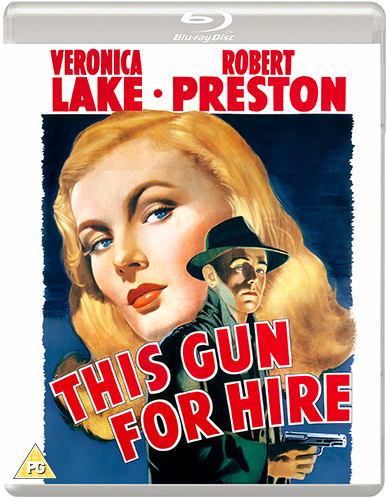
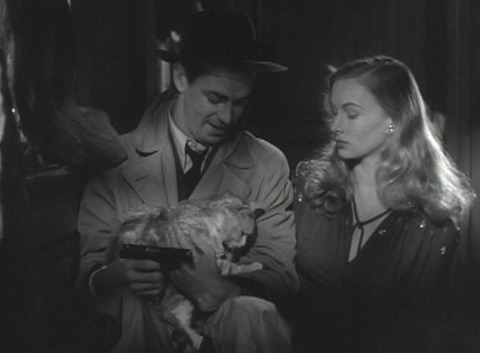
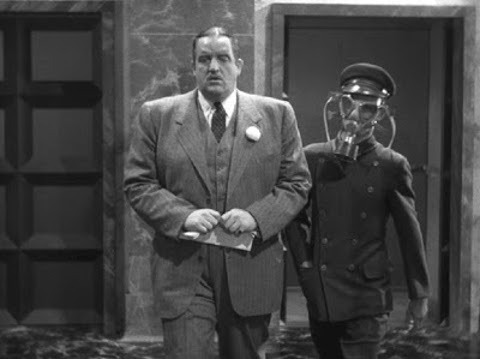

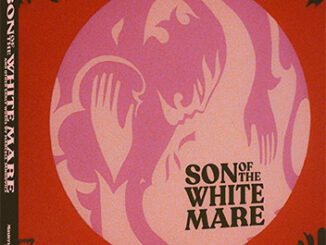
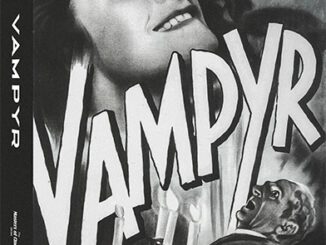
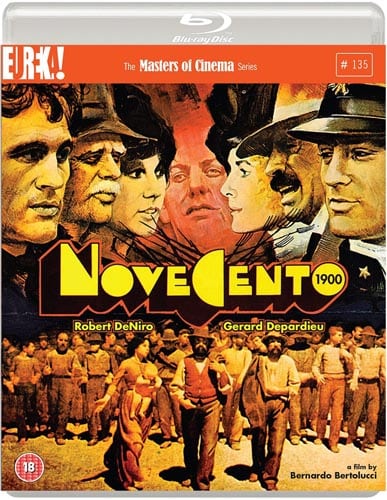
Be the first to comment